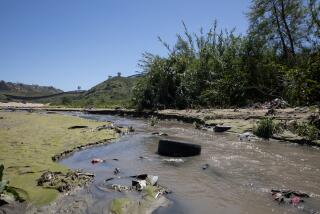EPA Wants Answers on Southland Beach Woes
Concerned by the rising number of beach closures across Southern California, the Environmental Protection Agency has launched a sweeping review of sewage collection systems in 25 coastal cities to determine whether the Clean Water Act is being violated.
The EPA has sent in-depth questionnaires to cities and sanitation districts from Santa Barbara to San Diego seeking documents about operations and maintenance of waste water lines. It also is requesting records of all leaks and spills into the ocean. In the coming months, inspectors also may be dispatched for on-site examinations of the underground pipes that carry sewage from homes and businesses to treatment plants.
The review, the first of its kind involving the Southern California coast, was prompted by several highly publicized beach closures in recent years, including one in 1999 that kept large parts of Huntington Beach off limits to swimmers for much of the summer.
Officials said that in addition to making sure that sewer operations comply with federal law, the review will help the EPA develop new regulations for waste water systems and their effect on ocean pollution.
âThereâs a general concern about all of the beach closures,â said Ken Greenberg, an environmental engineer heading the project for the EPA. âItâs important to check out the situation to see how [the sewer systems] are performing.â
Any cities found to be unlawfully discharging pollutants from sewage pipes into U.S. waterways without a valid federal permit could face civil, administrative or criminal fines ranging from $2,500 to $50,000 a day until the problems are fixed.
The review comes seven months after the EPA and state officials filed suit against Los Angeles, demanding that the city stop sewage spills that occur at an average rate of two per day.
Typically, waste water is flushed down sinks and toilets into underground sewer lines operated and maintained by cities or small sanitation districts. It is then channeled to a network of trunk lines, where some pipes are big enough to drive a car through.
These large collection pipes are overseen by agencies such as the Orange County and Los Angeles County sanitation districts. Officials from both agencies said their operations are in compliance with federal law and neither anticipates penalties.
âOur system has been pretty stable,â said Joe Haworth, spokesman for the Los Angeles County district, the regionâs largest with 1,300 miles of concrete pipes serving nearly 80 cities.
Haworth said his agency has spent $300 million since 1985 rehabilitating and updating the system, which has some parts dating back to the 1920s.
The Orange County Sanitation District checks its 650 miles of pipes on a regular basis, as frequently as every two months in areas prone to breaks and clogs.
âWe donât have any problems in our system,â said spokeswoman Lisa Lawson.
One city that has experienced major problems is Huntington Beach, where an estimated 71,324 gallons of raw sewage escaped each day from badly cracked clay pipes throughout the 1990s. The leaks have long been suspected of contributing to ocean pollution that has forced the periodic closure of beaches. In March, the city pleaded guilty to criminal charges for allowing the sewage to leak into the ground.
Huntington Beach city leaders said they welcome any EPA investigation that would shed light on infrastructure flaws. But they point out that they already are addressing the issue. Thousands of miles of lines have been videotaped and problem areas have been lined with protective slips. A monthly sewer fee of about $6 per household also is being considered to pay for improved maintenance.
âSewers are kind of out-of-sight, out-of-mind until someone calls attention to them,â said Councilwoman Connie Boardman. âAnything that helps cities and government agencies focus on their infrastructure is good.â
A report released this week by the Natural Resources Defense Council found that the number of beach closures in California and across the nation nearly doubled last year, a jump attributed primarily to more stringent testing of recreational waters.
Sewer leaks are considered the second most common cause of beach pollution. Urban runoff is the most common source. The mix of lawn fertilizer, pet waste, motor oil and other contaminants is swept off lawns and streets into storm drains and waterways that flow into the ocean.
More to Read
Sign up for Essential California
The most important California stories and recommendations in your inbox every morning.
You may occasionally receive promotional content from the Los Angeles Times.










